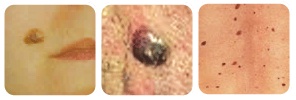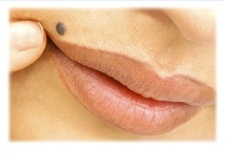Facts about Moles
Moles are common skin lesions named Naevi. Moles come in either subdermal or raised growths above the skin. Moles are comprised of melanin (the body’s natural pigmenting agent), this is what’s responsible for their dark hue.
Most lesions are benign (not maligant) and common types of moles include skin tags, raised moles, and flat moles.
Most moles shouldn’t cause any particular health risk, especially if they’re circular or oval and not terribly large.

Still if you find a mole on your body that’s unfamiliar to you, it’s best to have it checked out by a qualified specialist. Only a professional can determine whether or not a mole is malignant.
Options to remove lesions
There are several mole removal options available to you today.
- Surgical mole removal involves freezing the mole with liquid nitrogen and cutting the mole off with a scalpel. A couple of stitches should be sufficient in closing the wound. As you may expect, this type of surgery can leave behind scars and can be painful.
For surgery, many dermatologic and plastic surgeons first use a freezing solution, usually liquid nitrogen, on a raised mole and then shave it away with a scalpel.
If the surgeon opts for the shaving method, he or she usually also cauterizes the stump. Because a circle is difficult to close with stitches, the incision is usually elliptical or eye-shaped. However, freezing should not be done to a nevus suspected to be a melanoma, as the ice crystals can cause pathological changes called "freezing artifacts" which might interfere with the diagnosis of the melanoma.
Anaesthesia is needed, scars and infection are inevitable.
- Laser mole removal is another alternative for moles
removal. In
an expert hand, laser removal is effective against both flat
and raised moles. The laser removes the mole by evaporation, a process that also seals off any open wounds so there’s no need for stitches.
Often, there is little or no scarring using this method, although it may not be an option if your mole extends deep into your skin. The other disadvantage is much downtime and aftercare
- Micro-Thermocoagulation (Electrocautery) is a blending of radio and high frequency micro-currents which pass through or cut off the skin abnormality. The technique works on the principle of liquids being attracted to heat which is released by probes.
Treatments are very quick (some within a few minutes), and may not even touch the skin's surface. It is the elements of radio and high frequencies that arc onto the skin, which attracts the moisture located in the skin abnormalities, with a result of the abnormality being separated from the skin’s surface.
Various size of probes are available to precisely target the unwanted tissues for treatment and therefore does not damage surrounding tissues.
Most popular device Clinical Skin Clear (aka Lamprobe) can treat all minor skin lesions very effectively
Who should have Lesions removed?
Men and women who have either:
- a cosmetic mole ie unsightly or irritating or catches on clothing or when shaving
- a suspicious mole that is changing in size, shape or colour and/or itches and bleeds
Sometimes a lesion has to be removed because there is a risk it has become malignant (cancerous) or because it has become a nuisance (for example catching on clothes or a razor).




